AMD Athlon 64 4000+ & FX-55: A Thorough Investigation
by Anand Lal Shimpi on October 19, 2004 1:04 AM EST- Posted in
- CPUs
Microsoft Office XP SP-2
Here we see in that the purest of office application tests, performance doesn't vary all too much. The spread of performance here is around 6%, which is nothing terribly significant. While AMD continues to top the charts, Intel is basically on par with them here.
For doing the most basic work in Office, you'll find no real performance difference between a top of the line Intel and AMD machine. Head towards the mid range and you'll still find no real difference in performance, only in price.
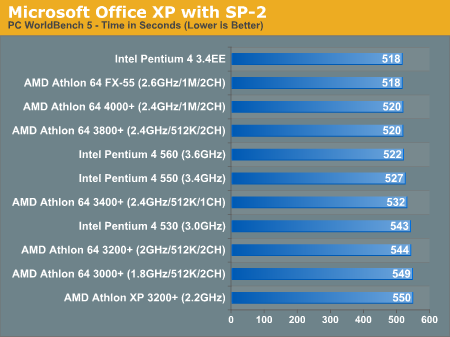
Mozilla 1.4
Quite possibly the most frequently used application on any desktop is the one we pay the least amount of attention to when it comes to performance. While a bit older than the core that is now used in Firefox, performance in Mozilla is worth looking at as many users are switching from IE to a much more capable browser on the PC - Firefox.
Here it's no secret that AMD is clearly on top in performance. What's
truly impressive is that the fastest Athlon 64 is able to complete the Mozilla
test in close to half the time of the Pentium 4 550. The performance advantage
the Athlon 64s hold over the Pentium 4s is impressive to say the least.
We continue to see that a dual channel setup gives the Athlon 64 around
a 5% performance boost. What is quite interesting is the 11% performance
improvement
thanks to a 1MB L2 cache that the 4000+ holds over the 3800+. What
this confirms is that the low memory access latencies provided for
by the
on-die memory
controller
of the Athlon 64 is largely responsible for the performance advantage
here. Looking at the 3.4EE we see that its large L3 cache is able to
make up
for the clock speed deficit, giving it the lead over the Pentium 4
560, further
confirming our statements on what matters when it comes to browser
performance.
Low latency memory accesses matter most here and AMD takes the crown. It is worth noting that you are generally going to be limited by the speed of your Internet connection when it comes to browser performance, however it is always nice to have the snappiest browser experience possible.
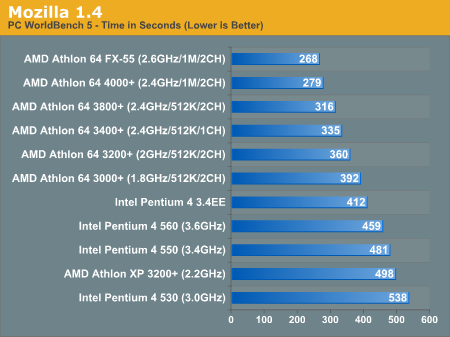
ACD Systems ACDSee PowerPack 5.0
ACDSee is a popular image editing tool that is great for basic image editing options such as batch resizing, rotating, cropping and other such features that are too elementary to justify purchasing something as powerful as Photoshop for. There are no extremely complex filters here, just pure batch image processing.
At 2.4GHz, AMD begins to take the lead from Intel, outperforming even the 3.4EE. The higher up the model number goes, the greater the gap continues to be. There isn't much of a performance difference between the three 2.4GHz chips from AMD, with the biggest difference actually being between the Athlon 64 3800+ and 3400+, or dual vs. single channel memory configurations for those feeling overwhelmed by model numbers. More cache doesn't seem to do much here, as these sorts of operations are largely bandwidth limited and exhibit very little temporal locality with respect to their datasets. We see a 6% gain in performance thanks to the dual channel memory controller of AMD's Socket-939 parts, which is about in line with what we've seen across the board.
The Pentium 4 530 does quite abysmally here, falling behind even the older Athlon XP 3200+. The rest of the Prescott line does appear to do much more reasonably, although at much higher prices than better performing AMD chips.

Ahead Software Nero Express 6.0.0.3
While it was a major issue in the past, these days buffer underrun errors while burning a CD or DVD are few and far between thanks to high performance CPUs as well as vastly improved optical drives. When you take the optical drive out of the equation, how do these CPU's stack up with burning performance?
As you'd guess, they're all pretty much the same, with the slight variations between chips falling within expectations. Any of these chips will do just fine.
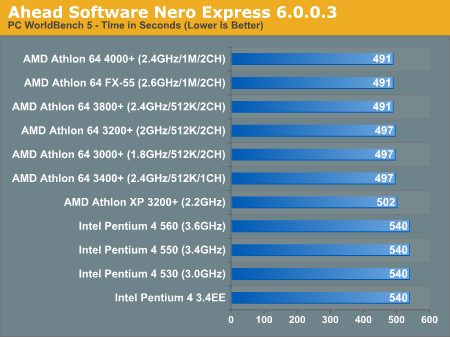
Winzip
Archiving performance ends up being fairly CPU bound as well as I/O limited. Here we continue to see AMD at the top of the charts, closely followed by the high end Intel chips. There's still a 5% performance difference between the single and dual channel 2.4GHz Athlon 64s, which we've been seeing over and over again. We don't see much of a performance boost with the 1MB cache of the 4000+, but the FX-55 does manage to slightly differentiate itself with its higher operating clock.
The Athlon XP does surprisingly well in this test, holding its own against the lower end Athlon 64s.
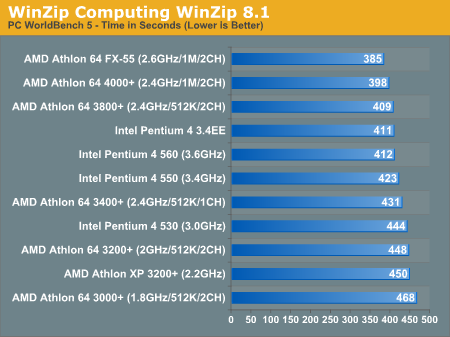
WinRAR 3.40
Pulling the hard disk out of the equation we can get a much better idea of which processors are truly best suited for file compression. While the hard drive hid a lot of the shortcomings of the Athlon XP in WorldBench's WinZip test, they are all revealed in WinRAR's built in benchmark that is largely disk I/O independent.
Here the Athlon 64s show a huge advantage over the Pentium 4 processors, with the slowest Athlon 64 outperforming the fastest Pentium 4 Extreme Edition. The real world performance implications are somewhere in between what we've shown with WorldBench 5's WinZip test and the built-in WinRAR benchmark, needless to say the victor continues to be AMD's Athlon 64.
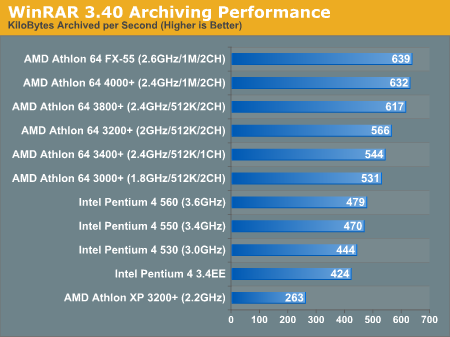










89 Comments
View All Comments
Live - Tuesday, October 19, 2004 - link
Splendid reading! This site is doing a great job right now. I really would love more of these very informative articles that help you so at seeing the big picture.A really helpful article.
Disorganise - Tuesday, October 19, 2004 - link
I’m a bit disappointed by you inconsistency…The comparison with Intel over who wins….slightly inconsistent but no biggie.
What really is bad though, is the penultimate page – is socket 939 worth it?
I agree it is but…..
You’ve taking an identical chip and found it about 5% quicker than on socket 754. OK, no problem. But AMD have wacked a whopping 12% increase in rating, to 3800+ from 3400+. It doesn’t gel, the numbers don’t work.
The 3800+ is also more expensive than the 3400+ to the tune of about 250% here in Australia and about 220% over there in the U.S. a 5% increase in performance does not warrant a doubling in price.
Dave
at80eighty - Tuesday, October 19, 2004 - link
way to go Anand...excellently comprehensive article.../waiting for those HDD articles you promised : p
SLIM - Tuesday, October 19, 2004 - link
Going along with what #6 said:Athlon 64 4000+ - 2.4GHz - 1MB - 128-bit
Athlon 64 3800+ - 2.4GHz - 512KB - 128-bit
Athlon 64 3400+ - 2.4GHz - 1MB - 64-bit <---should be a socket 754 3700+ right?
Athlon 64 3400+ - 2.4GHz - 512KB - 64-bit
Athlon 64 FX-53 - 2.4GHz - 1MB - 128-bit
SLIM
ViRGE - Tuesday, October 19, 2004 - link
#12, even GPUs aren't going anywhere fast. There's still a shortage of something or other needed to make the Ultra/PE parts, and there isn't a planned refresh for 2004. ATI/Nvidia have another speed grade of RAM to jump to(1.6ghz GDDR3), and can die-shrink down to 90nm once TSMC gets there, but they're so close to CPUs right now, they're destined to hit the same wall too.Anand, someone has been a busy beaver.;-) That was a long, but well thought out and informative article; you've basically written the definitive CPU article for now until the multicores come out.
Tides - Tuesday, October 19, 2004 - link
Ah I read the conclusion wrong.Tides - Tuesday, October 19, 2004 - link
why is this site putting down an amd performance gain and making excuses for intel at the same time.Doormat - Tuesday, October 19, 2004 - link
Its a shame the processor wars are coming to an end. I see dual core as neat, but a dud performance wise. It'll be another year or two before the GPU wars start to die out... hmmm..-CPU performance levels off
-HD capacity levels off
The only interesting stuff going on is GPU stuff.
dvinnen - Tuesday, October 19, 2004 - link
Best artical from Anandtech I've read in a long time. Good job Anand.skiboysteve - Tuesday, October 19, 2004 - link
wait nevermind, you put your comments ABOVE the graphs. threw me off cause this isnt what you usualy do...